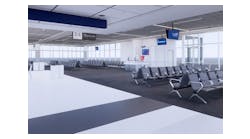Listen Up: The Importance of Hearing Protection in the Construction Industry
As someone who has spent nearly two decades in the construction industry, I’ve experienced the noise level of job sites, from jackhammers drilling the ground, saws cutting lumber, bulldozers, dump trucks and more. Because of that symphony of sounds, construction is undoubtedly one of the noisiest industries in which to work.
Sound intensity is measured in units called decibels (dBA). The National Institute for Occupational Safety and Health (NIOSH) outlines the recommended occupational exposure limit as 85 dBA. Prolonged exposure to sounds over 85 dBA or higher can cause ear damage and increase the chances of developing hearing loss. While that may not sound like much, construction equipment regularly reaches a dBA that’s higher than recommended. For example, forklifts emit sounds of 90 dBA, and hammer drills can reach up to 120 dBA.
Running my business, Weinbaum Management Group (WMG), a leading owner’s representation and construction management firm based in Los Angeles, requires me to spend much of my time on job sites versus an office. At our job sites, team members hold meetings in the midst of a cacophony of construction noise, where hearing protection is often neglected. Not on purpose, but rather, it’s an afterthought or an inconvenience. Earlier in my career, it didn’t seem like much of a problem, but 18 years in, I wonder what would be different had I used hearing protection.
Hearing loss is personal for me. In 2020, at age 37, I was diagnosed with an adenoma tumor of the middle ear in my left ear. What was thought to be a severe ear infection was a tumor so rare it has only been identified in 48 cases between 1970-1995. During this diagnosis, I went to an audiologist for a baseline hearing test, which I majorly failed. And while my left ear was impacted due to the tumor, my right ear was also hearing less sound than normal. Test results showed I suffered from sensorineural hearing loss in my right ear, which is hearing loss caused by damage to the inner ear or nerve from the ear to the brain. Sensorineural hearing loss is permanent, and at the young age of 37, there was no other explanation for this condition other than prolonged exposure to loud noise, which was a regular part of my job.
I likely wouldn’t have caught the right ear hearing loss until later, when it was much worse. I’m now committed to sharing my experience with others to help prevent hearing loss in the construction industry. Although it's not often talked about, it’s certainly not uncommon. According to a 2020 CDC report, approximately 51 percent of construction workers have been exposed to hazardous noise and 14 percent of all construction workers have hearing difficulty.
Unfortunately, hearing loss is irreversible, but there are steps to take to prevent any future hearing loss.
Understand the Noise Level Limits
Knowledge is power. It’s hard to know what level of noise is “too loud.” Whether it’s concerts, personal earbuds or even a sound machine, many would be surprised at what they deem as normal is actually hurting their hearing. According to the CDC, noise above 70 dB over a prolonged period of time may start to damage your hearing. Loud noise above 120 dB can cause immediate harm to your ears.The higher the noise level, the faster the hearing loss.
For that reason, I no longer use personal earbuds to listen to music or podcasts, and I always bring hearing protection with me to concerts. There are many free smartphone apps that can check decibel levels in real-time. These easy-to-use apps ensure you’re at a safe level and determine if you need to move locations.
Schedule an Annual Hearing Test/Hearing Check
Having my hearing checked, especially at a young age, was not something I ever considered, but now I wish I had. Most insurance, including Medicare, will cover a comprehensive hearing exam if you have a referral from a healthcare provider. Those who are frequently exposed to loud noises like I am have a higher risk of damage to their hearing and should have their hearing checked once a year. Any accrued cost will likely be much less than that of hearing aids, which are very expensive and often not covered by insurance.
As of mid-October 2022, the U.S. Food and Drug Administration (FDA) made hearing aids available over the counter, and at a lower price point, allowing Americans to purchase more affordable hearing aids. While this lowers the cost from the thousands to now hundreds for many pairs, having your hearing checked annually helps avoid having to purchase any at all.
Carry (and Use) Hearing Protection at All Times
I always have a pair of earplugs handy - whether I’m on a job site or not. There are varying levels of hearing protection, from heavy duty ear muffs for onsite work, or regular ear plugs to use during concerts or other personal activities. According to the University of Rochester Medical Center, wearing earplugs or earmuffs is effective and reduces noise by approximately 15 to 30 decibels if worn correctly. If you already suffer from hearing loss, you should still wear hearing protection in noisy environments to prevent further damage.
In my experience, hearing protection is often passed out at job sites, but rarely used because it can be inconvenient and challenging to hear others during meetings and conversations. That said, all job site personnel should carry them and make sure to use them when needed.
Encourage Others to Protect Their Hearing
It’s no secret job sites are loud, but it’s what people do with that information that makes a difference. Telling others about the dangerous effects of loud noise and the importance of wearing hearing protection is key.
Following my life-altering diagnosis, my mission is to raise awareness about the health effects of noise-induced hearing loss and prevention, especially among professionals in the construction industry. As part of this mission, WMG donates the equivalent of a pair of hearing aids (~$3,000 value) during the holiday season to the Hearaid Foundation.
Not only can hearing loss be a costly expense, but it impacts peoples’ quality of life, which is an even higher price to pay. My doctor told me this when he first discovered the tumor. While my condition thankfully wasn’t life-threatening, it was life-altering.
Hearing loss shouldn’t be a prerequisite to a construction career. It will take mindset shifting and habit building, but I hope my story encourages others to start protecting their hearing now so that both their senses and careers thrive for a long time to come.
As President and Founder of WMG, Lauren has spent nearly two decades in the construction industry and experienced the impact of noise-induced hearing loss. She can be reached at [email protected].





